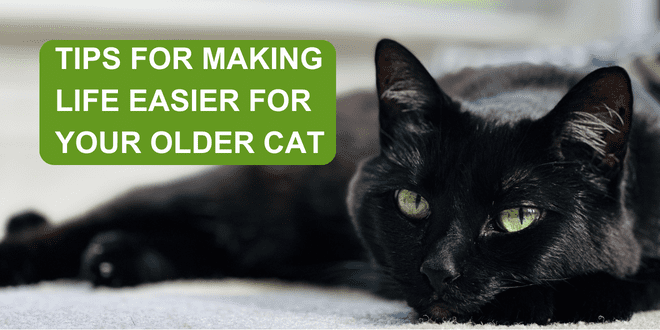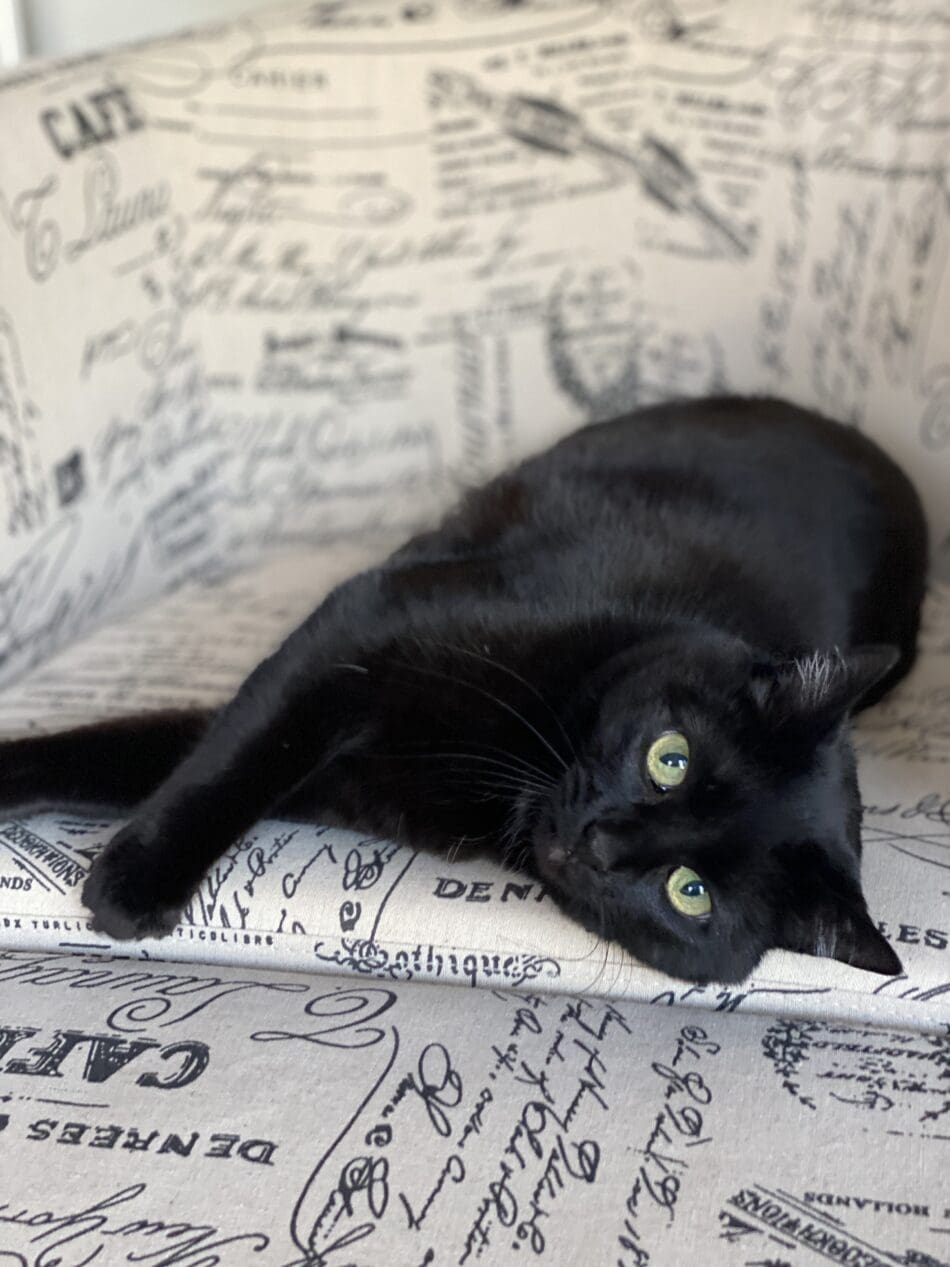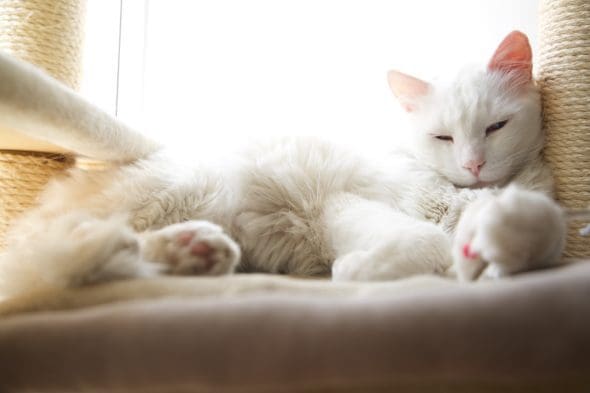
You may have an older cat who doesn’t seem to have slowed down one bit or maybe your cat is barely making it to the litter box these days. Just as with people, each cat handles the aging process differently. Some are active all through their senior years and some show obvious signs of slowing down when they pass through those years and enter the geriatric phase. For many cat parents though, it can be easy to overlook subtle signs that the cat isn’t quite as active and youthful as they once were. Here are reminder tips to help you care for your older cat.
Pay Attention to Changes in Your Cat
This applies to behavior, eating, water intake, litter box habits, activity level, vocalization, affection, and so on. Since cats are creatures of habit, a change – even a subtle one – can be a potential red flag that something is brewing. If there is an underlying medical problem, the sooner it’s addressed, the better the chance of it being corrected or maintained successfully.
Don’t Skip Veterinary Visits
When your cat was younger you probably brought him for an annual check-up and vaccinations. Now that your cat is older, twice-yearly visits are recommended. Even if you have opted to no longer have your cat vaccinated, he still needs to be examined. Take advantage of any senior wellness packages your veterinarian offers.
Maintain a Sound Nutritional Program for Your Older Cat
Your veterinarian may recommend that your cat stay on his current food but they may advise switching to a senior formula or even a prescription diet based on a diagnosis of a particular medical issue. Every nutrient counts! If you’re feeding raw or a homemade diet, consult with your veterinarian or veterinary nutritionist in case changes need to be made or if you need to tweak things a bit based on your cat’s specific situation.
Cats in general tend to naturally eat smaller, more frequent meals. For an older cat, this may become even more important. Your veterinarian may advise increasing meal frequency to make it easier on your cat’s stomach.
Don’t allow your cat to become overweight. Obesity isn’t healthy for a cat at any age but for an older kitty, those added pounds put extra stress on joints which can be very painful if arthritis is present. Obesity can also increase the risk of diabetes and heart disease.
For some old cats the problem becomes trying to keep weight on. If your cat isn’t able to maintain a healthy weight, talk to your veterinarian. After a thorough examination, supplements may be prescribed or flavor additives may be recommended. Some older cats lose their appetite as their sense of smell deteriorates. Warm food slightly to bring out more aroma. Your veterinarian can advise you on whether to include additives with a strong aroma or taste to entice your cat.
Make sure your cat is staying hydrated. Provide fresh water in several locations to encourage your older cat to drink enough water. Kidney issues can be a common medical issue in older cats so it’s vital that your cat has easy access to fresh water. Wash bowls daily as well to avoid a build-up of biofilm bacteria.
Cats fed dry food need to drink more water than cats fed wet food. Your veterinarian may recommend incorporating more wet food into your cat’s diet or gradually switching to an all-wet food diet altogether.
The type of food and water bowls you’ve always used may need to switched to elevated ones now. It may be more comfortable for your cat to keep his neck in a neutral position when eating or drinking instead of having to bend down. This is especially crucial if your cat has developed arthritis or any other mobility issues. Elevated bowls can easily be found at your local pet product store or online.
Maintain Your Cat’s Good Oral Health
If you haven’t been regularly brushing your cat’s teeth. it’s never too late to start. If you can’t brush the teeth, talk to your veterinarian about using an oral hygiene spray. In some cases, the veterinarian may recommend a professional cleaning. This is done while the cat is sedated. If your cat isn’t eating well, there’s a possibility it could be related to periodontal disease so it’s important to maintain your cat’s oral health. Oral infections and periodontal disease can enter the bloodstream and affect the health of your cat’s organs.
Signs that your cat may be experiencing dental pain can include change in eating habits, excessive drooling, pawing at mouth, increased vocalization, bad breath, chewing on only one side of the mouth, poor hair coat or foul odor to the hair coat.
Grooming
As your cat ages, he may no longer have the desire or strength to maintain his coat. Help out by gently brushing every day. This will help distribute skin oils. It will also feel like a wonderful massage if done correctly. Your older cat’s skin is very sensitive and if he has lost weight, the spine will be protruding so be very gentle when brushing. Grooming your cat is also a time when you can gently examine his body to check for any suspicious lumps.
Maintain Age-and-Health-Appropriate Activity for Your Older Cat
Keep those joints lubricated and muscles toned by encouraging your cat to participate in some degree of play and activity. Your cat may not leap off the ground when chasing a toy but any form of exercise is beneficial. Customize the activity to comfortably accommodate his physical ability. For some cats, even just light playtime will help circulation and joint mobility.
Mental activity is also important. When you engage in daily interactive play sessions, allow your cat opportunities to stalk, pounce and capture. For solo play, introduce puzzle feeders (customize so they’re appropriate for your cat’s ability) to maintain mental stimulation.
Environmental enrichment is still important for your older cat. Provide scratching posts, places to climb (safely), and other forms of stimulation, including visual, scent, and auditory.
Make Environmental Changes as Necessary for Your Cat
This may include getting a low-sided litter box to make it easier for an arthritic cat to get in and out as well as increasing the number of boxes. Your cat may not have the bladder control he did as a younger cat so provide more boxes in very convenient locations. Place boxes where he spends the most time so he doesn’t have far to walk. If your cat isn’t as accurate in the litter box anymore, place absorbent pads under and around the litter box. Remember to frequently change them out and clean the area. Another option is to put the litter box inside a very large, low sided container to catch any spills.
You might also have to create an easier way for your cat to get to any favorite elevated perch. A multi-perched cat tree is a good option. If your cat likes to sleep on the bed he may need stairs or a ramp to make it easy to go up and down. And speaking of beds, your cat may appreciate having a heated bed for cat naps. If using a heated bed, ensure he is mobile enough to move away from the heat if he gets too warm. A safer option is to use the beds that reflect the cat’s body heat so they can’t overheat and risk burning a cat’s sensitive skin. You can find these beds at your local pet product store and online. Provide some non-heated options as well.

Photo: Pam Johnson-Bennett
If your cat is experiencing a decline in vision, install nightlights, especially near resources such as the water bowl and litter box. If your cat has difficulty navigating through the house in the evening when everyone has gone to bed, set up nightlights or put lamps on dimmer switches so you can maintain enough light for comfortable and safe movement.
If your cat is losing hearing or doesn’t hear at all, avoid startling him. Always gently come into his visual field before picking him up.
If you suspect hearing loss or vision loss in your cat, here is some information to help you better communicate.
Minimize Your Cat’s Stress
As we all know, stress can cause havoc with health and as your cat ages he’ll be less able to deal with the effects of stress. Be aware of potential stressful situations in the environment so you can reduce exposure. For example, if you’re having lots of company over it might be best to put the senior cat in a separate room where it’s quiet. A cat who once enjoyed being the center of attention when guests visit may no longer welcome being handled or disturbed. In a multipet household, be aware of whether your senior cat is becoming the target of aggression or whether he’s getting nosed out of the food bowl or favorite napping areas.
Pay attention to changes in your household and lifestyle and how it could affect your cat. Understandably, changes in life happen, such as the need for renovation, job schedule changes, changes in family, moving to a new home, and so on. Ease your cat through those life changes. Cats of any age don’t like change, especially abrupt ones, but it’s more difficult for older cats to adjust to unexpected situations.

Photo: Liliana Marin for Unsplash
Some cat parents with senior cats attempt to adopt a young kitten. Some do it in preparation for the time when the older cat will pass, others do it in an attempt to ignite a spark in the senior or geriatric cat. My advice? Don’t do it. The last thing your older cat needs is added stress. Kittens are a bundle of nonstop energy with little to no territorial understanding yet. Your older cat doesn’t need that in his life right now.
Watch for Signs of Pain
Don’t just assume your cat’s decrease in activity or change in temperament is simply due to old age. I’ve seen many cat parents write off a cat’s change in disposition as just typical aging-related crankiness. Your cat may actually be in pain. Cats are good at hiding pain so you need to be observant for any change. Consult your veterinarian because your cat may be experiencing pain from arthritis or any number of age-related issues.
If your cat does have joint pain, help reduce that pain by keeping him at a healthy weight.
Your Older Cat’s Temperature Intolerance
As cats age they can become more sensitive to temperature changes. If your cat normally loves to sit in the window in order to watch the outdoor activities it may be too drafty there in winter months. Ensure that your cat’s favorite windows are securely sealed to reduce drafts. You can also find heated window perches in several styles. Look for a heated bed that reflects the cat’s body temperature. These beds are very safe and can be placed anywhere because they don’t need to be plugged in. For some cats, just being able to curl up in a donut-shaped or cave-style bed can be cozy enough and can help retain warmth, and as mentioned earlier, if using a plug-in heated bed, make sure your cat is mobile enough to be able to move away from it.
Time to Move Your Cat Indoors
If your cat has been an indoor/outdoor cat in the past, this is the time to make that indoor transition. A cat with declining senses and limited mobility is at a higher risk of being on the wrong end of a fight with another animal. Your cat is also more vulnerable to injuries caused by accidents as well as being susceptible to disease and parasites. If there is any cognitive decline, your indoor/outdoor cat may get confused and no longer be able to find his way back home. In colder months, being outdoors can aggravate pain from arthritis.
Be Tolerant and Compassionate with Your Older Cat
Age isn’t easy for anyone – human, cat or dog. As your cat ages he may develop poor aim when in the litter box, he may become less tolerant of things he used to accept willingly, he may not have the best table manners when eating, he may not groom to perfection and may not want to give up his claimed spot on the bed in order to make room for you. Be careful when picking up your cat as he might experience pain from arthritis or stiff joints. If your cat has experienced a decline in senses, avoid startling him if vision or hearing aren’t what they used to be. Help your cat with the things you can and be tolerant of the things you can’t change. With your help, your cat can have a wonderful and comfortable life as a senior citizen.
Need More Information?
For more information on cat behavior and training, check out the best-selling books by Pam Johnson-Bennett. Pam’s books are available at bookstores and online. We’ve included Amazon links here on our website.
If you have a question about your cat’s behavior or health, contact your veterinarian. This article is not intended as a medical diagnosis nor is it a replacement for your cat’s regular veterinary care. This article is for general information purposes only.


